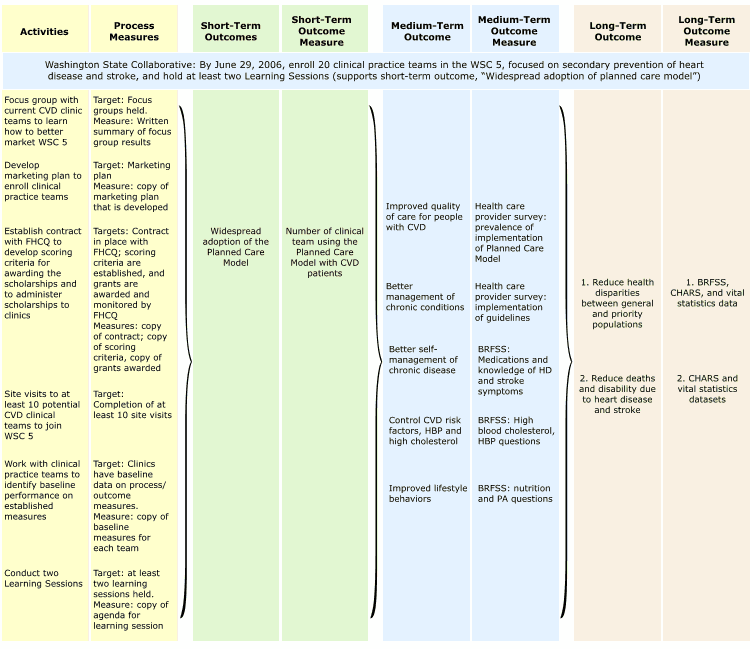
Figure 2. Washington State Heart Disease and Stroke Prevention Program (WaHDSPP) Logic Evaluation Plan, 2005–2006. (WSC indicates Washington State Collaborative; CVD, cardiovascular disease; FHCQ, Foundation for Healthcare Quality; HBP, high blood pressure; BRFSS, Behavioral Risk Factor Surveillance System; HD, heart disease; PA, physical activity; and CHARS, Comprehensive Hospital Abstract Reporting System.)
This figure contains a series of boxes arranged into eight columns, each of which contains a title box: 1) Activities, 2) Process Measures, 3) Short-Term Outcome, 4) Short-Term Outcome Measure, 5) Medium-Term Outcome, 6) Medium-Term Outcome Measure, 7) Long-Term Outcome, and 8) Long-Term Outcome Measure. Underneath these eight heading boxes is one long, rectangular box that stretches the length of the figure. The following text is contained in the long box: Washington State Collaborative: By June 29, 2006, enroll 20 clinical practice teams in the WSC 5, focused on secondary prevention of heart disease and stroke, and hold at least two Learning Sessions (supports short-term outcome, “Widespread adoption of planned care model”). Underneath the heading box of the first column, entitled “Activities,” are the following six bullet points: 1) focus group with current CVD clinic teams to learn how to better market WSC 5; 2) develop marketing plan to enroll clinical practice teams; 3) develop marketing plan to enroll clinical practice teams; 4) site visits to at least 10 potential CVD clinical teams to join WSC 5; 5) work with clinical practice teams to identify baseline performance on established measures; and 6) conduct two learning sessions.
Underneath the heading box of the second column, entitled “Process Measures,” are six bullet points. The first bullet point says, “Target: Focus groups held. Measure: Written summary of focus group results.” The second bullet point says, “Target: Marketing plan. Measure: copy of marketing plan that is developed.” The third bullet point says, “Targets: Contract in place with FHCQ; scoring criteria are established, and grants are awarded and monitored by FHCQ. Measures: copy of contract; copy of scoring criteria, copy of grants awarded.” The fourth bullet point says, “Target: Completion of at least 10 site visits.” The fifth bullet point says, “Target: Clinics have baseline data on process/outcome measures. Measure: copy of baseline measures for each team.” The sixth bullet point says, “Target: at least 2 Learning Sessions held. Measure: copy of agenda for learning session.” The first two columns are connected to the third and fourth columns with a right-pointing bracket.
Underneath the heading box of the third column, entitled “Short-Term Outcome,” is the following information: Widespread adoption of the Planned Care Model. Underneath the heading box of the third column, entitled “Short-Term Outcome Measure,” is the following information: Number of clinical team using the Planned Care Model with CVD patients. The third and fourth columns are connected to the fifth and sixth columns with a right-pointing bracket.
Underneath the heading box of the fifth column, entitled “Medium-Term Outcome,” are five bullet points. The first bullet point says, “Improved quality of care for people with CVD.” The second bullet point says, “Better management of chronic conditions.” The third bullet point says, “Better self-management of chronic disease.” The fourth bullet point says, “Control CVD risk factors, HBP and high cholesterol.” The fifth bullet point says, “Improved lifestyle behaviors.”
Underneath the heading box of the sixth column, entitled “Medium-Term Outcome Measure,” are five bullet points. The first bullet point says, “Health care provider survey: Prevalence of implementation of Planned Care Model.” The second bullet point says, “Health care provider survey: Implementation of guidelines.” The third bullet point says, “BRFSS: Medications and knowledge of HD and stroke symptoms.” The fourth bullet point says, “BRFSS: High blood cholesterol, High blood pressure questions.” The fifth bullet point says, “BRFSS: Nutrition and PA questions.” The fifth and sixth columns are connected to the seventh and eighth columns with a right-pointing bracket.
Underneath the heading box of the seventh column, entitled “Long-Term Outcome,” are the following two bullet points: 1) Reduce health disparities between general and priority populations; and 2) Reduce deaths and disability due to heart disease and stroke. Underneath the heading box of the eighth column, entitled “Long-Term Outcome Measure,” are the following two bullet points: BRFSS, CHARS, and Vital Statistics data; and 2) CHARS and Vital Statistics datasets.
![]()
Volume 5: No. 2, April 2008